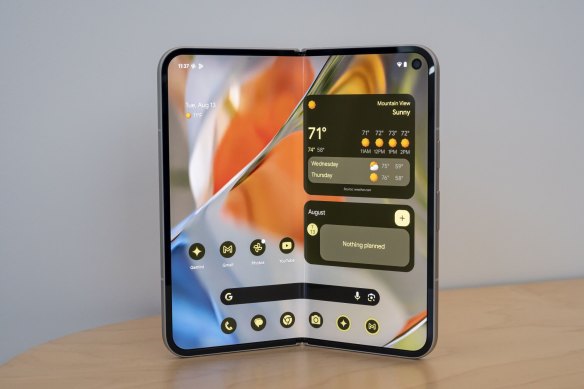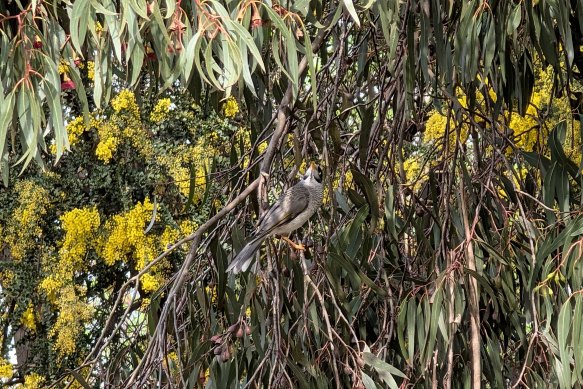
Outside these features, quieter examples of AI continue to make the Pixel an excellent overall smartphone, from improving call quality and even answering suspicious incoming calls for you, to being able to pull up web results on anything you see if you circle it.

A folding version of the Pixel 9 Pro is also coming soon.Credit: Bloomberg
Taking photos
Pixels have long had incredible point-and-shoot cameras that regularly outperform other premium smartphones, and that continues here. On the Pro model, a new 42MP front camera hands in great selfies in almost all lighting conditions, and can pull back wide for group shots. On the rear, the combo of wide, ultra-wide and telephoto gives clean results as close as 2 centimetres from the subject (given enough light and a steady hand) and as far as 10x zoom.
In like-for-like conditions, Google produces the most true-to life-pictures compared with current Apple and Samsung phones, in my opinion. Colours are not over-saturated or too warm, and artificial lighting tends to be correctly accounted for. Portrait blurring and panorama mode are certainly not infallible, but generally look great.
However, the clear focus for Google in building its photography system going forward is in AI tools, which are more numerous than ever in the Pixel 9 Pro. And while they all work, the results do invariably have an AI air about them, and applying AI editing to personal photos continues to feel a bit less comfortable than your usual cropping and filters.

Even at more than 10x zoom, the Pixel 9 Pro captures some very nice images.Credit: Tim Biggs
A new feature called Zoom Enhance is more or less that magical technique used by TV detectives on CCTV stills, except in this case it’s using generative AI to guess what something would look like in greater detail than the camera actually captured. If you’re zoomed in more than 15x, this feature will automatically apply when you take the picture, but you can also edit any photo you’ve taken with the phone, zoom in and activate Zoom Enhance to clean it up. It works better than the blurry or pixelated results you’d expect on most phones, but the pictures absolutely end up with telltale AI artefacts like strange skin textures, wrong colours or heavy inky lines.
Add Me, another new feature, is designed to address that common problem where you’re not in a group photo because you were the one taking the photo. You activate the mode, take the photo, then hand the phone to a friend and go to where the group just was. Your friend will see you superimposed on the photo you took, and when they hit the shutter the system will stitch it all together. The feature has problems if it needs to put you on a plush couch or in complex shadows, but it’s as competent as a pretty good Photoshop.
And more AI
The AI-powered Magic Editor, which you can use to touch up even the oldest photos taken on other phones, also has some new features. Auto Frame will analyse a photo and give you some framing options to choose from based on different photography techniques. It might straighten, crop, zoom or even step back away from the subject. Obviously, many of these options require the AI to completely invent new surroundings, so results will vary.
Loading
In one example, I reframed a photo of my son taken from behind, while he was riding a scooter. The system flipped it from portrait to landscape orientation, and moved the subject from the middle of the shot to the bottom third, which at first glance makes for a much better photo. But it also means around half of the photo is completely fake, and if you look closely you can see melted-looking car bodies, power lines that don’t connect to anything, and what appears to be a stack of cement blocks with bits of hi-vis stuck to them.
The Re-imagine option in Magic Editor is a bit more directed, in that you can highlight any photo element (as though you were going to remove it with the Magic Eraser) and type in a text prompt to transform it. That could mean asking for fireworks in the sky behind you, or turning an unwanted “no smoking” sign into a band poster. As ever with these things, some results are near-indistinguishable from reality, and some are completely wretched.
For video, most AI features arrive when you switch on something called Video Boost, which sends your backed-up videos to a Google server for processing. The video you take is available instantly, but it generally takes a few hours for the boosted version to arrive. Boosting smooths out blur and adds in details for videos zoomed in past 5x, fixes colour, makes low-light footage much more discernible and optionally increases resolution to 8K so you can take decent stills from the video. In my limited testing it did an excellent job at improving nighttime video, just like Night Sight does for still photos. I’m keen to try it out at a concert though and see how the AI deals with capturing a performer’s details at a distance and with a lot of movement.
Get news and reviews on technology, gadgets and gaming in our Technology newsletter every Friday. Sign up here.









 Add Category
Add Category